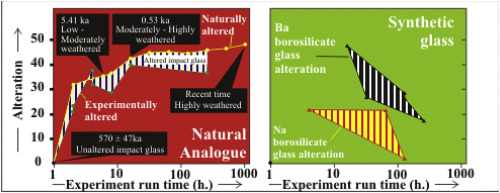当前位置:
X-MOL 学术
›
Appl. Geochem.
›
论文详情
Our official English website, www.x-mol.net, welcomes your
feedback! (Note: you will need to create a separate account there.)
Impact glass applied as a standard for long-term performance assessment of Na–Ba borosilicate glass forms in geological environment
Applied Geochemistry ( IF 3.1 ) Pub Date : 2020-03-01 , DOI: 10.1016/j.apgeochem.2019.104477 Amit Kumar , J.P. Shrivastava , Meenakshi , Sundeep Chopra , Sattam Chakraborty
Applied Geochemistry ( IF 3.1 ) Pub Date : 2020-03-01 , DOI: 10.1016/j.apgeochem.2019.104477 Amit Kumar , J.P. Shrivastava , Meenakshi , Sundeep Chopra , Sattam Chakraborty

|
Abstract High-level nuclear waste is usually immobilized into high silica glass matrix for long-term and safe disposal in the geological repository. Performance of glass forms is uncertain for the lack of standardization against a natural analogue. Thus, alteration studies were performed on the impact glass as it is surviving in a natural environment since its inception (570 ka). Further, these results were compared to laboratory induced alteration in the impact glass and Na and Ba borosilicate glass from the literature. Alteration experiments were carried out in the de-ionized water under accelerated conditions at 100 °C temperature and 17.24 bar pressure in a variable time framework. Owing to rapid dissolution of synthetic glass, Al3+, Ca2+, K+, Mg2+, Na2+ and Si4+ were released into the solution and finally secondary silicates (SS) were formed in the residue. Comparing to impact glass, a three-fold higher alteration rate is noticed in the Na and Ba borosilicate glass forms. X-ray diffraction (XRD) and scanning electron microscopic (SEM) - energy dispersive X-ray spectrometric (EDS) analyses revealed formation of secondary mineral assemblages (analcime, aragonite, illite, montmorillonite, saponite and stilbite) for both naturally and experimentally altered impact glass types. Moreover, nontronite phase was formed as a major post-alteration product in Na and Ba borosilicate glass forms. The neo-formed SS were compared to naturally derived SS from the impact glass in three time domains of (1) 570 to 5.41 ka, (2) 5.41 to 0.53 ka and (3) 0.53 to Recent Period as determined by high resolution 14C Accelerator Mass Spectroscopy (AMS). Naturally altered impact glass presents paragenetic order of saponite > calcite > montmorillonite > montmorillonite/chlorite mixed layer > siderite > chabazite > aragonite > analcime. As compared to the impact glass, synthetic glass structure is very weak and friable towards alteration. Former attended as a more reliable standard glass.
中文翻译:

冲击玻璃用作地质环境中 Na-Ba 硼硅酸盐玻璃形式长期性能评估的标准
摘要 高放核废料通常被固定在高硅玻璃基质中,在地质处置库中长期安全处置。由于缺乏针对天然类似物的标准化,玻璃形式的性能不确定。因此,对冲击玻璃进行了改变研究,因为它自诞生以来(570 ka)就在自然环境中幸存下来。此外,将这些结果与来自文献的冲击玻璃和钠和钡硼硅酸盐玻璃的实验室诱导变化进行了比较。在 100 °C 温度和 17.24 bar 压力的加速条件下,在可变时间框架内,在去离子水中进行了改变实验。由于合成玻璃、Al3+、Ca2+、K+、Mg2+、Na2+ 和 Si4+ 被释放到溶液中,最终在残留物中形成二次硅酸盐 (SS)。与冲击玻璃相比,Na 和 Ba 硼硅酸盐玻璃形式的变化率高出三倍。X 射线衍射 (XRD) 和扫描电子显微镜 (SEM) - 能量色散 X 射线光谱 (EDS) 分析揭示了天然和实验改造的次生矿物组合(方解石、文石、伊利石、蒙脱石、皂石和辉石)的形成冲击玻璃类型。此外,作为 Na 和 Ba 硼硅酸盐玻璃形式的主要变质后产物,形成了绿脱石相。在 (1) 570 至 5.41 ka、(2) 5.41 至 0.53 ka 和 (3) 0 三个时域中,将新形成的 SS 与来自冲击玻璃的天然衍生 SS 进行比较。53 至近期,由高分辨率 14C 加速器质谱 (AMS) 确定。自然蚀变冲击玻璃的共生顺序为皂石>方解石>蒙脱石>蒙脱石/绿泥石混合层>菱铁矿>菱沸石>文石>方沸石。与抗冲击玻璃相比,合成玻璃结构非常脆弱且易变质。前者作为更可靠的标准玻璃参加。
更新日期:2020-03-01
中文翻译:

冲击玻璃用作地质环境中 Na-Ba 硼硅酸盐玻璃形式长期性能评估的标准
摘要 高放核废料通常被固定在高硅玻璃基质中,在地质处置库中长期安全处置。由于缺乏针对天然类似物的标准化,玻璃形式的性能不确定。因此,对冲击玻璃进行了改变研究,因为它自诞生以来(570 ka)就在自然环境中幸存下来。此外,将这些结果与来自文献的冲击玻璃和钠和钡硼硅酸盐玻璃的实验室诱导变化进行了比较。在 100 °C 温度和 17.24 bar 压力的加速条件下,在可变时间框架内,在去离子水中进行了改变实验。由于合成玻璃、Al3+、Ca2+、K+、Mg2+、Na2+ 和 Si4+ 被释放到溶液中,最终在残留物中形成二次硅酸盐 (SS)。与冲击玻璃相比,Na 和 Ba 硼硅酸盐玻璃形式的变化率高出三倍。X 射线衍射 (XRD) 和扫描电子显微镜 (SEM) - 能量色散 X 射线光谱 (EDS) 分析揭示了天然和实验改造的次生矿物组合(方解石、文石、伊利石、蒙脱石、皂石和辉石)的形成冲击玻璃类型。此外,作为 Na 和 Ba 硼硅酸盐玻璃形式的主要变质后产物,形成了绿脱石相。在 (1) 570 至 5.41 ka、(2) 5.41 至 0.53 ka 和 (3) 0 三个时域中,将新形成的 SS 与来自冲击玻璃的天然衍生 SS 进行比较。53 至近期,由高分辨率 14C 加速器质谱 (AMS) 确定。自然蚀变冲击玻璃的共生顺序为皂石>方解石>蒙脱石>蒙脱石/绿泥石混合层>菱铁矿>菱沸石>文石>方沸石。与抗冲击玻璃相比,合成玻璃结构非常脆弱且易变质。前者作为更可靠的标准玻璃参加。











































 京公网安备 11010802027423号
京公网安备 11010802027423号